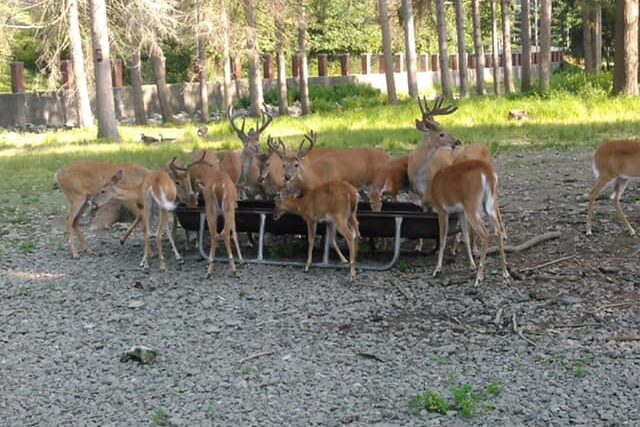The white-tailed deer that inhabit Cortland Waterworks have been a staple in the community. However, there is a part of their story that is not discussed.

The Cortland Water Board was the beginning of Waterworks that is known today. In 1883, 14 village residents organized an application to the trustees to form a water works company to supply pure water to the village of Cortland. The trustees approved and the Cortland Water Board officially opened in 1884. The springs of Otter Creek were used as the water supply. It wasn’t 1910 that the city of Cortland wanted in on the water business and different ownership of the Cortland Water Board created the Cortland Waterworks.
Cortland Waterworks went on to be more than a utility service, as Danny Houlihan created the idea for animals, the Christmas lights, and flora that is still seen today. The very first Christmas light display was in 1949, and the number of deer that inhabited the area at the time was 16. After a windshear destroyed the fence surrounding the Waterworks in 1986, the 16 deer were free to roam. However, all the deer returned as they were not far from the area and were use to being fed. The new fence was rebuilt around them.
The deer population of 16 grew as more deer were being taken in and born. Deer that have imprinted on humans have been surrendered to the Waterworks. In addition, to several giving birth to multiple fawns at a time. The herd has been around since the 1940s and is still existent to this day.
The herd is regulated by the NYS Department of Agriculture and Markets, and Mike Dexter is the current caretaker. The City of Cortland Police Department also updates the public with photos on Facebook, as the public has displayed worries about the herd in the past. There is a Facebook page that the public has used in the past to address their concerns.
Despite the concerns about lumps on the deer and cases of excess drooling and physical abnormalities, the herd is well taken care of by Mike Dexter and receives veterinarian care when needed. They have all been affirmed as healthy as questions of their health and chronic waste disease were raised.
Chronic waste disease is a neurological disease that is passed through direct contact of saliva and waste from the infected animal or indirectly through contaminated water and plants. It causes drooling, loss of weight, loss of balance, change in walking, and death.
“We have annual inspections and testing for various diseases including chronic waste. We do not have chronic waste disease in our herd and have never had it in the past,” said Matt Wethje, Chief Water System Operator of the Cortland Water Department.
The New York State Department of Environmental Conservation has also reaffirmed there have never been as cases of chronic waste disease (CWD).
The part of the Waterworks Deer that is not spoken about is the inbreeding that’s possibly going on. There have been conversations from several Cortland professors that have claimed that the deer are inbred and are not capable of being released into the wild. Their familiarity with human interaction also doesn’t make them suitable for release.
However, with the deer in close capacity for 80 years, the genetic variability decreases. The idea of genetic drift, change in a population’s genome over time, is a real concern. With there being a limited gene pool, it makes mating of related deer far more likely. It then lowers the genetic diversity and creates genetic health issues like deformities or more vulnerable to illness. This is another variable of why the deer can’t be released into the wild, while also acknowledging their domestication is another factor as to why.
The physical abnormalities that are present when a deer is inbred are humped noses, overbites or underbites, irregular patches of white fur, deformed limbs, and curved spines. Some deer at the Waterworks appear to have some of these features.
The possibility in whether the deer are inbred is possible, and has been confirmed by conservation biology professors at SUNY Cortland. However, the officials that look over the herd have not confirmed or commented on that possibility.
The Waterworks deer are a staple to the Cortland community for almost a century. The herd holds a story that is more complex than it seems.